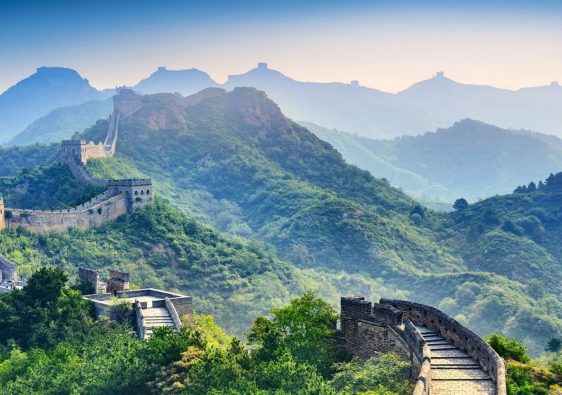East Khasi Hills is perhaps best known for Sohra (Cherrapunjee), geographically famous for being the wettest place on earth, and also Shillong, one of the most beautiful hill stations in India.
It is one of the populated districts of Meghalaya, having many tourist destinations to visit. Mawlynnong which is known as the cleanest village of India is situated in this district. The double-decker living root bridge is somewhat that tourists should experience. Mawphalang which means ‘grassy stones’ is known for the sacred forests and living root bridges.
In fact, the entire region that forms the central part of Meghalaya is richly endowed with natural beauty. Everywhere you go, you will never cease to be mystified by the spectacular charm the state offers.
The enchanting Meghalaya boasts of a diverse array of forests that capture the imagination of any and every adventurous soul who has set foot there.
Here are the 6 Beautiful Places To Visit In Meghalaya’s East Khasi Hills.
1. Shillong
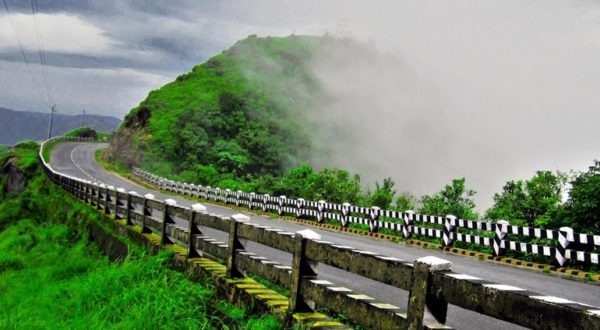
Known for the manicured gardens at Lady Hydari Park, Shillong is a hill station in northeast India and the capital of the state of Meghalaya which is the only hill station in the country that is accessible from all sides.
The name Shillong is derived from U-Shyllong, a powerful deity that is situated at an altitude of 1,491m above sea level. Shillong is one of the important tourist destinations in the northeast that is often referred to as the “Scotland of the East” due to its striking similarity with the Scottish highlands.
Here, taking a mild walk or riding slowly a vehicle on the road alongside Khasi hills gives many glimpses of the valley and a clear perception of the beauty epitomized by Nature in the capital of Meghalaya. Very easily people find themselves lost counting the ways Nature on hills can surprise them. The same theory applies in Shillong as well, especially during monsoons, that’s why you shouldn’t miss exploring Shillong on your Meghalaya trip.
Attractions: Lady Hydari Park, Ward’s Lake, Cathedral Catholic Church, Capt. Williamson Sangma State Museum, Don Bosco Centre for Indigenous Cultures, Golf Course, Spread Eagle Falls, Sweet Falls, Ever-Living Museum, Elephant Falls & Shillong Peak
Best Time to Visit Shillong: The best time is considered to be from September to May, however, to enjoy eight waterfalls and lush greenery in the area no season could be better than Monsoon.
2. Sohra (Cherrapunjee)
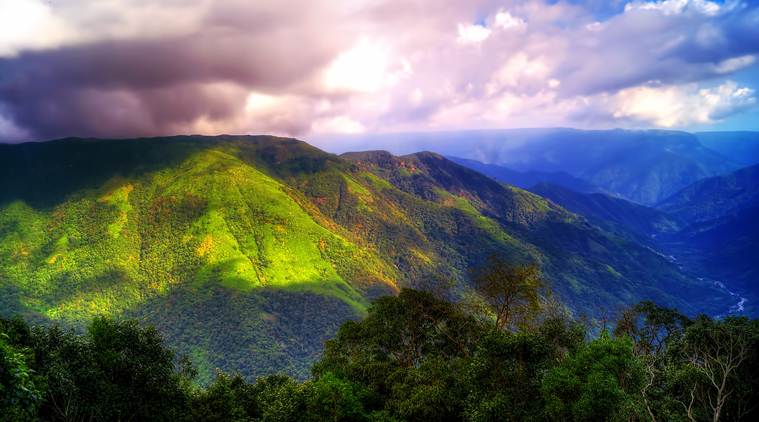
Known for its living root bridges, made from rubber trees, Cherrapunjee, also known as Sohra, is a high-altitude town in the northeast Indian state of Meghalaya. It is 56 km from Shillong and is literally the high point of any visit to Meghalaya that is set upon a plateau on the southern slopes of the state.
Sohra is dotted with waterfalls cascading over deep gorges. The swift-flowing rivers and streams flow in a southerly direction to the plains. It is one of those ultimate eco-friendly destinations, a place renowned all over the world for having the privilege of receiving the highest rainfall in the world.
A unique annual meteorological phenomenon directly influenced by the southwest monsoon and the northeast winds. The heavy monsoon rains over these mountains undoubtedly create in Sohra one of the rarest bio-diverse vegetations in the world.
Set against the backdrop of a breath-taking landscape, it is a place to discover the Indian summer monsoons. Sohra, truly a beautiful corner in northeast India, waiting to be discovered and explored by you.
Attractions: Mawkdok Dympep Valley View, Sa-I-Mika Park, Dain-Thlen Falls, Noh-Kalikai Falls, Ka Kper Syiem Sohra, Nongsawlia, Mawmluh Cave, Eco Park, Mawsmai Cave, Noh-Sngithiang Falls, Thangkharang Park, Ka Khoh Ramhah, Kynrem Falls & The Lawshynna Cave
Best Time to Visit Sohra (Cherrapunjee): Cherrapunjee receives heavy rainfall throughout the year. So, the best time to visit Cherrapunjee is between the months of October and May, when the weather remains cool and pleasant.
3. Laitkynsew
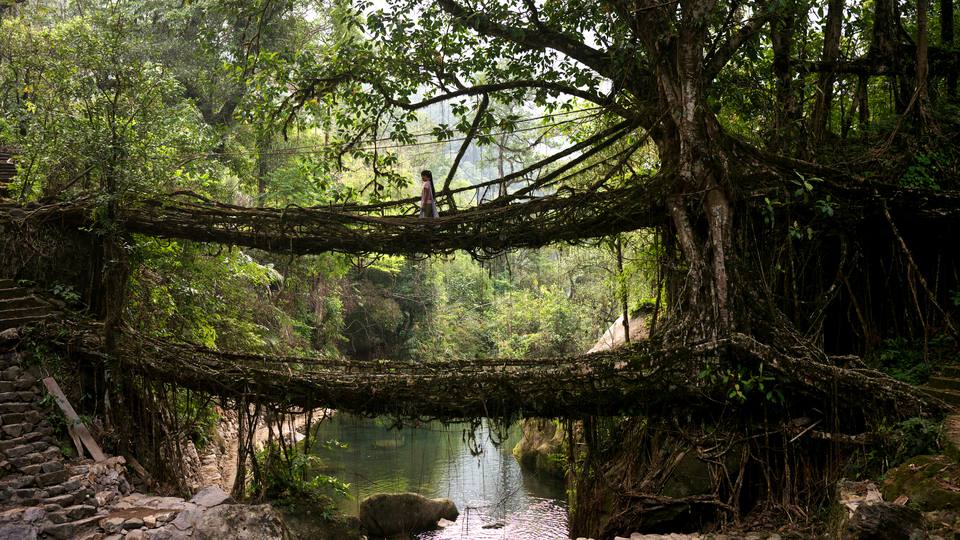
Best known for its living root bridges, Laitkynsew is a village in the East Khasi Hills district of Meghalaya State, in north-eastern India. The Umnnoi living root bridge, known locally as Jingkieng Deingjri, which means ‘bridge of the rubber tree’, is 53 feet long and over 100 years old.
15 km further from Sohra (Cherrapunjee) there is a holiday resort run by a private party that offers visitors treks around the picturesque hills, a spring bath, the thrills of caving, and many other forms of excitement. Close to the resort, there is the living root bridge across a torrential stream, that any visitor would love to see where in the adjacent village of Nongriat two such living bridges have been created by weaving and inter-twine roots of the same banyan tree. It has come to be referred to as Jingkieng Nongriat or more commonly Double Decker.
Laitkynsew is one of the must-visit places in the East Khasi Hills district of Meghalaya due to its living root bridges.
Attractions: Ummunoi Root Bridge, Umkar Root Bridge, Ritymmen Root Bridge, Umshiang Double Decker Root Bridge & Mawsaw Root Bridge
Best Time to Visit Laitkynsew: One can explore the beautifulLaitkynsew in the beginning or by the end of the monsoon season when the rains are not heavy and the terrain is mesmerizingly beautiful.
4. Mawsynram
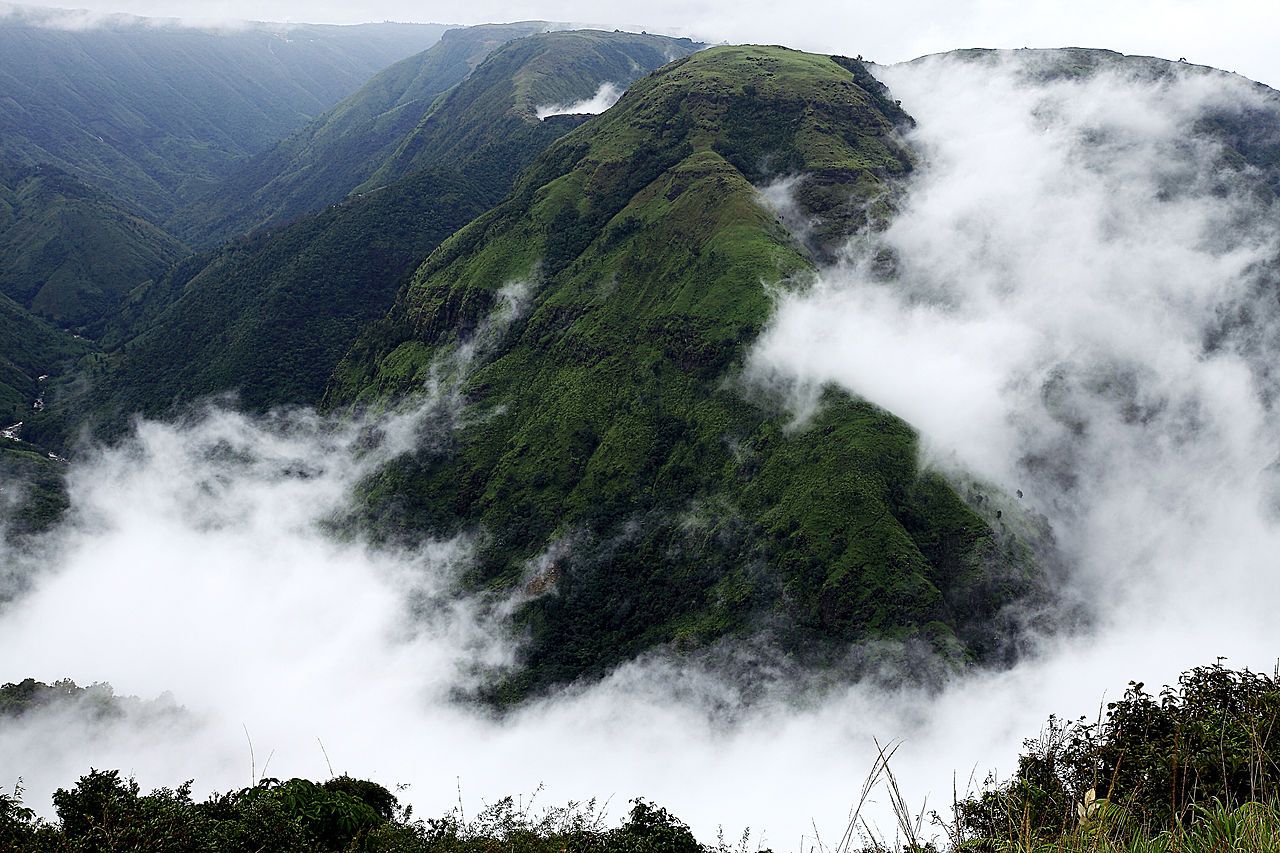
Mawsynram is a village in the East Khasi Hills district of Meghalaya state in north-eastern India that is 56 km from Shillong.
It receives the highest rainfall in India and the World, that’s why acknowledged as one of the wettest places in the world.
The mesmerizing village of Mawsynram is a nature lover’s delight and the perfect destination to behold the beauty of the rains.
Mawsynram is a place where nature-loving people frequently visit wherein they take pleasure in the steep, sliding slopes, the fresh air, the rolling green mountains, and the deafening but beautiful waterfalls. The village is also well known for its huge formation of a stalagmite, which takes after the shape of a ‘Shivling’.
Mawsynram fame draws an endless stream of guests from across the country and abroad which is a nature lover’s delight.
Attractions: Mawjymbuin, Mawjymbuin Cave, Krem Dam, Krem Puri Cave, Lum Symper & Krem Puri Cave system
Best Time to Visit Mawsynram: Mawsynram is known to be one of the wettest places on the earth. It is, therefore, best when visited between April and June which is the summer season in the country.
5. Mawlynnong Village
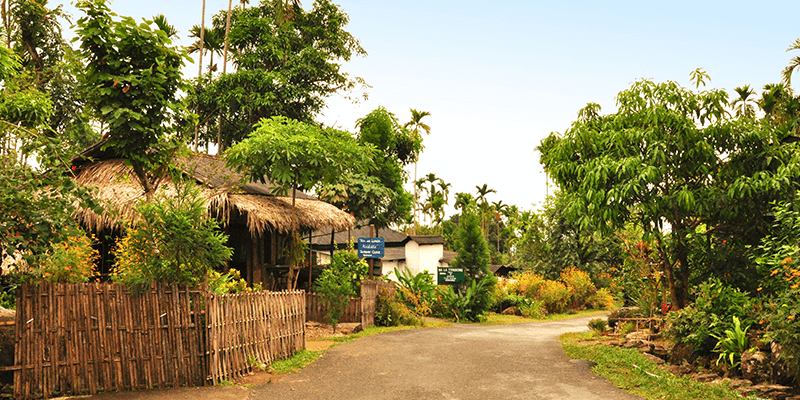
Notable for its cleanliness, Mawlynnong/Mawlynnong Village located in the East Khasi Hills of Meghalaya, also referred to as ‘God’s own garden’ has won the acclaim of being the cleanest village in Asia in 2003.
It is situated 90 km from Shillong and besides the picturesque village, offers many interesting sights such as the living root bridge and another strange natural phenomenon of a boulder balancing on another rock.
The village is quite pretty, especially in the monsoons when there is lush greenery all around, with waterfalls paving the way to small streams and abundance of flowering orchids dangling from the trees and hedges add to the beauty of the village.
Mawlynnong’s fame is now drawing an endless stream of guests from across the country and abroad which is an artist’s delight and the sort of getaway that would titillate creative writers and poets.
Attractions: Living Root Bridge, Balancing Rock of Mawlynnong, Byrdaw Falls, Church Of The Epiphany, Urkyrming Waterfall, Wah Rymben, Rymben Falls & Mawshun Cave
Best Time to Visit Mawlynnong Village: June to November
6. Mawphlang
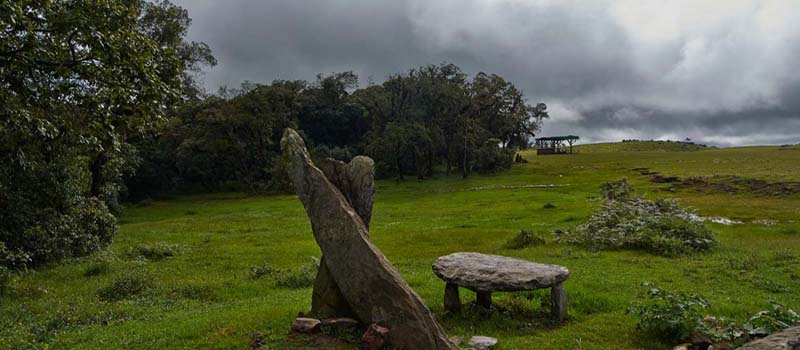
Mawphlang is a village in the East Khasi Hills district of Meghalaya that is 25 kilometers from Shillong. The village lies in the district of East Khasi Hills and is famous for its sacred groves. The sacred grove has an amazing life form of plants, flowering trees, orchids, and butterflies.
An ideal destination for nature lovers. The word maw means “stone”, maw phlang means “grassy stone,” and is one of many settlements in the Khasi hills named after monoliths. The monolith has been preserved to introduce tourists to the Khasi Tribes and their lifestyle in nature’s lap. The sacred forest is also a famous attraction in Mawphlang which is of immense spiritual importance to the Khasis. The forest is home to a variety of flora and fauna and is a perfect destination for nature walks or trekking making it a true paradise for nature lovers.
Attractions: Ward’s Lake, Laitkor Peak, Elephant Falls, Mawphlang Sacred Grove, Air Force Museum, Khasi Hills, Laitlum Grand Canyon, Mawphlang David Scott Trail, Dainthlen Falls, Arwah Cave, Khasi Heritage Village, Wei Sawdong, Mawkdok Dympep Valley View Point, Beadon Bishop View Point, Garden Of Caves, Mawryngkhang Trek & Duwan Sing Syiem View Point
Best Time to Visit Mawphlang: The best time to visit Mawphlang is between September and May as the weather stays pleasantly cold and dry most of the days making it perfect for travelers who wish to explore the village.




